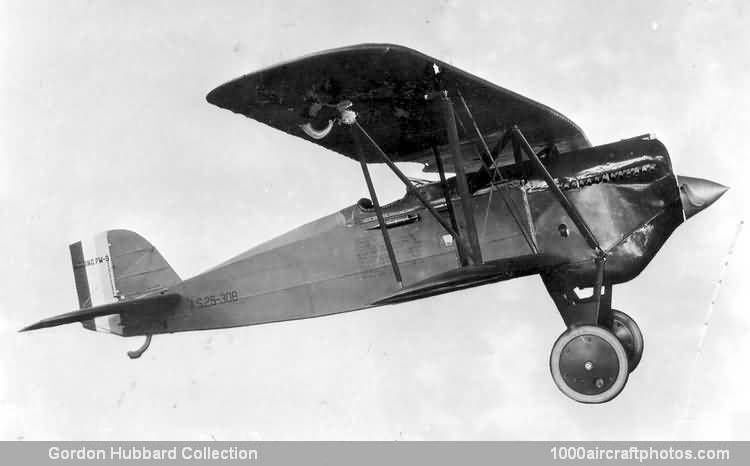09/30/2014. Remarks by Johan Visschedijk: "Boeing's connection with US Army fighters began in 1921, when the company successfully bid for a contract to build 200 MB-3As of Thomas Morse design. While these were being built, work began on a new single-seat fighter prototype, the Boeing Model 15, as a private venture. First flown by Frank Tyndall on April 29, 1923, the Model 15 was tested by the Army later that year at McCook Field. Although the private venture Curtiss XPW-8 had already been tested and ordered into production, the Boeing design was sufficiently promising for the Army to purchase the prototype, serialed 23-1216, and order two more examples (s/n 23-1217, 23-1218) in September 1923 which were then designated XPW-9 in the liquid-cooled pursuit category.
Powered by a 435 hp Curtiss D-12 engine, the XPW-9 had a steel tube fuselage structure and wooden wings, all fabric covered. All three had straight axle landing gear, but a split axle type was later tested on 23-1216, and was then used on production models. Following further comparative tests with the XPW-9s, a production order was placed on September 19, 1924, for twelve Boeing PW-9s (s/n 25-295 to 25-306), this order being increased to thirty on December 16 (s/n 25-307 to 25-324). These aircraft were similar to the prototype, but the final eighteen were strengthened to the same standard as the Navy's FB-1 version. One PW-9 was fitted with all-metal wings with corrugated dural top skin and fabric undersurfaces built by Thomas Morse.
Further orders for the PW-9 followed. In October 1925, a batch of 25 was ordered, these being PW-9As (Boeing Model l5A, s/n 26-351 to 26-375) with duplicated flying and landing wires to increase the safety factor. Another fifteen were ordered in June 1926 as PW-9B (s/n 26-443 to 26-457) but were converted to PW-9C before completion, and a second batch of 25 PW-9Cs (Boeing Model15C, s/n 27-178 to 25-202) was ordered in August 1926. Changes again were small, including cockpit and landing gear details and larger wheels. The final contract was placed in August 1927 for sixteen PW-9D (s/n 28-026 to 28-041) after the last PW-9C had been converted to the prototype PW-9D (Boeing Model 15D). Differences in the D-model included a new radiator, revised cowling lines and rudder balance area (which was added retroactively to earlier models). All models from A to D were powered by the 440 hp Curtiss D-12 (V-1150) engine.
No PW-9s were built after 1928, but several were converted to other models. The last PW-9 (s/n 25-324) became the XP-4 when fitted with a turbocharged 500 hp Packard 1A-1500 and longer span bottom wings. Performance was poor and only five hours flying was done. The final PW-9D (s/n 28-41) became the XP-7 with a 600 hp Curtiss V-1570-1 and deep chin radiator. It was later reconverted to PW-9D and a contract for four service test P-7s was cancelled. The 24th PW-9A (s/n 26-374) was modified into the single-seat AT-3 advanced trainer, with a 180 hp Wright V-720 (Model E) engine."
